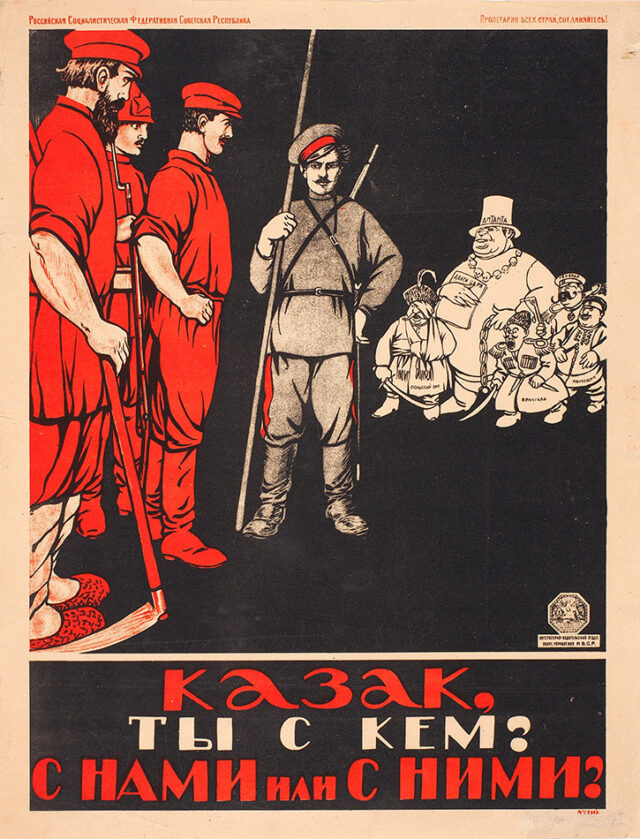
Cossack Warriors From Russia and Abroad Meet in Moscow
Publication: Eurasia Daily Monitor Volume: 20 Issue: 181
By:

On November 25, a “Big Circle” (Bol’shoi Krug) meeting of “over 200 delegates from 83 regions of Russia and 43 countries of the world” took place in Moscow to discuss Cossack issues and confirm the election of Chief Ataman Nikolai Dyakanov as leader of the Union of Cossack Warriors of Russia and Abroad (SKVRiZ). SKVRiZ represents some 30,000 “unregistered” or “public” Cossacks and maintains connections with organizations in Russia and many other countries. Largely on Dyakanov’s own initiative, the public Cossack organization “became an army,” sending volunteer battalions to fight in Russia’s so-called “special military operation.” Some Cossack attendees came to the meeting directly from the Ukrainian front, still dressed in combat fatigues (Rossisskaya gazeta, November 12). Such a spectacle seemingly confirms that the enhanced ideological significance of the war for those who identify as Cossacks contributes to the proliferation of paramilitary groups within Russia and implies a greater role for the Cossacks, both registered and unregistered, in future combat operations (see EDM January 30, February 14).
Nikolai Doluda, ataman of the All-Russian Cossack Society (VsKO), claimed that the SKVRiZ is “the most powerful and numerous” organization for unregistered Cossacks. It is distinct from the VsKO, which coordinates activities for Cossacks registered with the Russian state. Doluda declared, “We are all Cossacks in spirit and are not indifferent to the future of Russia or the Cossacks” (All-Russian Cossack Society, November 13). Also present at the meeting were representatives of the Federation Council, Presidential Administration, State Duma, Russian Orthodox Church, and Foreign Ministry, underlining the importance of the Cossacks for Moscow in achieving its geopolitical goals. The Cossacks appear to be some of the Kremlin’s most devoted warriors. Two Cossack fighters have already received the “Hero of Russia” medal for their service in Ukraine, 10 percent of the Don brigade have been awarded the “Order of Courage” and other military honors, and many Cossacks are re-upping their service contracts to either return or stay in Ukraine (Pravda.ru, November 12)
Dyakonov underlined the ideological commitment of his troops, saying that “for us, it is not simply a military operation, but a holy war.” He added that the lands where most Cossacks have been fighting in Ukraine—Zaporizhzhia Oblast, Kherson Oblast, and the Kinburn Spit—are those of “military glory for Russian Cossackdom,” such that “our Cossacks are defending the land watered by the blood of their ancestors” (Komsomolskaya Pravda, November 14). The officials participating in the meeting went on to advocate for regular rotations in the combat zone and claimed that 70 percent of Cossacks from the Russian Far East have joined in Moscow’s invasion of Ukraine.
The Cossack attendees openly shared that Cossack groups have been replacing the void left by the Wagner Group’s exit from the Ukrainian battlefield. Andrei Polukhanov, commander of the “Scythian” Cossack battalion, said that “half a year ago, we replaced the Wagnerites in Soledar and Artemivsk … and no one believed that we would hold out. But in this time, we have never backed down. And we are even advancing, causing big problems for the enemy” (Kommersant.ru, November 14). His statement confirms the role of the Cossacks in effectively taking up Wagner’s positions in Ukraine and the Kremlin’s continued reliance on private military companies in the combat zone. Many former Wagnerites have connections to Cossack organizations. This makes fighting these mercenary organizations similar to fighting the Hydra: if you cut off one head, two more will grow back.
The “Big Circle” illustrates the sheer number of extra bodies that Moscow has available to throw into the “meat grinder” in Ukraine. The SKVRiZ contains 30,000 members ready to participate in conflict operations. It also speaks to Moscow’s recruitment strategies both inside and outside Russia. The “ancestral” or “ethnic” Cossacks, whom SKVRiZ represents, are far more numerous than the state-registered Cossacks that Doluda leads, estimated at around five million (Gordeev, Istoriaa Kazachestva, 2006). Appealing to organizations representing these Cossacks will likely be more popular than relying solely on Russia’s “cosplay” Cossacks. Despite the dominance of Russian Orthodoxy, the Cossack movement also includes other major faiths such as Islam. For example, Muslim Cossacks from Bashkiria said they lived with the Orthodox Cossacks “as brothers,” and their ataman, Sayfullin, accepted a sword promising “to serve the Fatherland, the Cossacks, and the Islamic faith” (Kommmersant.ru, November 14). Such inclusiveness cannot help but broaden the pool of potential recruits for the Kremlin.
The SKVRiZ also represents a means of appealing to Cossacks in other parts of the post-Soviet space and beyond who are not Russian citizens. This year, the Kyrgyz Cossacks entered the SKVRiZ union structure. Additionally, the SKVRiZ has worked with the Seven Rivers Cossack Host based in Kyrgyzstan and Kazakhstan for a long time to facilitate “the rebirth of the Cossacks” in those countries. This is now yielding increased influence and presumably additional fighters for Russia (EADaily.ru, May 25, 2020). For example, Cossacks from Belgium, Germany, and Finland also attended the “Big Circle” meeting in Moscow (Kommersant.ru, November 14).
The threat posed by Russia’s ongoing recruitment of registered and unregistered Cossacks could extend well beyond Ukraine. While it is hard to imagine a serious kinetic threat to the West from these smaller Cossack groups, a German intelligence officer with Cossack associates was detained after networking with far-right extremists in the country (Tagesschau.de, November 8, 2022). Russia may lean on these Cossack organizations in the future to sow discord and instability throughout Europe. The SKVRiZ “Big Circle” meeting thus emphasizes how Cossacks continue to play a key role as a kinetic and hybrid threat in Russia’s war against Ukraine and the collective West.



